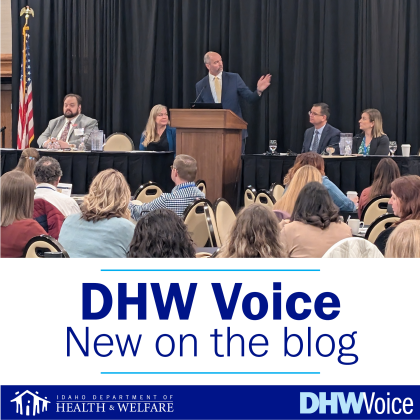Child welfare is not the responsibility of one agency or one group—it takes all of us. From judges to foster families, attorneys to caseworkers, nonprofit advocates to faith leaders, every person who touches the child welfare system plays a role in shaping better outcomes for Idaho’s children and families.
That spirit of shared responsibility was on display at the Children and Families Institute Conference in Boise on April 17, where more than 300 attorneys, judges, advocates, nonprofit representatives, and Department of Health and Welfare (DHW) staff gathered to collaborate on how best to support vulnerable families. The conference was put on by the Administrative Office of the Courts.
DHW leaders kicked off the two-day event with a panel presentation and discussion about the department’s efforts to double the rate of foster families in Idaho—a goal that relies on strong partnerships across systems.
“It takes all of us,” said DHW Deputy Director Monty Prow. “Everybody in this room who’s worked with these issues knows that there’s usually not just one piece of the system. It takes guardian ad litems, DHW staff at all levels, certainly members of the court, and advocates along the way—to support where we’re trying to head in order to be leaders and innovators in this space.”
Highlights from DHW’s panel included:
Prow also spoke about the department’s goal of improving child welfare including the reorganization of child welfare services from one division into two smaller divisions: Youth Safety and Permanency, which handles traditional child welfare work, and Family and Community Partnerships, a new DHW division that’s harnessing the power of community to support foster families.
Youth Safety and Permanency Deputy Administrator Wendy Seagraves gave a status update about the department’s work. The rate of foster homes in Idaho has increased from 0.74 in June 2024 to 0.94 now. The number of kids in congregate care in the same timeframe has reduced from 240 to 180 kids. The department has stopped using short-term rentals, and it’s reduced the number of out-of-state placements by nearly 50%.
Legislative and Regulatory Affairs Chief Jared Larsen reported on 2025 legislative and regulatory changes impacting foster families, emphasizing that these changes allow the courts more latitude to consider what’s in the best interest of children.
Family and Community Partnerships Administrator Laura Denner reiterated the importance of partnerships and the inclusion of foster families into events. She highlighted several upcoming events and developing partnerships.
Director of Faith Based Initiatives Sage Dixon said his office is focused on reaching out to the faith community to help recruit foster parents, treatment foster families, and to provide additional support for existing foster and adoptive families.
The impacts of these innovations and milestones show that when people and groups work together, they produce better outcomes for a bright future for Idaho’s families.
The DHW panelists offered a special thanks to the courts for inviting the department to be a part of the day’s training. DHW looks forward to continued collaboration to improve the lives of Idaho’s youth and families.
The Idaho Department of Health and Welfare is dedicated to strengthening the health, safety, and independence of Idahoans. Learn more at healthandwelfare.idaho.gov.

Join the Discussion
Please note the following terms of participation in commenting on the DHW Voice blog.
To ensure a productive discussion you agree to post only comments directly related to this post and to refrain from posting obscenities; threatening, abusive or discriminatory language; sexually explicit material; and other material that would violate the law if published here; promotional content; or private information such as phone numbers or addresses. DHW reserves the right to screen and remove inappropriate comments.